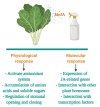Improving the Health-Benefits of Kales (Brassica oleracea L. var. acephala DC) through the Application of Controlled Abiotic Stresses: A Review
- PMID: 34961097
- PMCID: PMC8706317
- DOI: 10.3390/plants10122629
Improving the Health-Benefits of Kales (Brassica oleracea L. var. acephala DC) through the Application of Controlled Abiotic Stresses: A Review
Abstract
Kale (Brassica oleracea L. var. acephala DC) is a popular cruciferous vegetable originating from Central Asia, and is well known for its abundant bioactive compounds. This review discusses the main kale phytochemicals and emphasizes molecules of nutraceutical interest, including phenolics, carotenoids, and glucosinolates. The preventive and therapeutic properties of kale against chronic and degenerative diseases are highlighted according to the most recent in vitro, in vivo, and clinical studies reported. Likewise, it is well known that the application of controlled abiotic stresses can be used as an effective tool to increase the content of phytochemicals with health-promoting properties. In this context, the effect of different abiotic stresses (saline, exogenous phytohormones, drought, temperature, and radiation) on the accumulation of secondary metabolites in kale is also presented. The information reviewed in this article can be used as a starting point to further validate through bioassays the effects of abiotically stressed kale on the prevention and treatment of chronic and degenerative diseases.
Keywords: carotenoids; controlled abiotic stresses; glucosinolates; health-promoting properties; isothiocyanates; kale; nutraceuticals; phenolic compounds; secondary metabolism; superfood.
Conflict of interest statement
The authors declare no conflict of interest.
Figures




References
-
- Vidal N.P., Pham H.T., Manful C., Pumphrey R., Nadeem M., Cheema M., Galagedara L., Leke-Aladekoba A., Abbey L., Thomas R. The Use of Natural Media Amendments to Produce Kale Enhanced with Functional Lipids in Controlled Environment Production System. Sci. Rep. 2018;8:14771. doi: 10.1038/s41598-018-32866-5. - DOI - PMC - PubMed
-
- USDA Agricultural Research Service: Kale Raw. [(accessed on 3 October 2020)];2017 Available online: https://fdc.nal.usda.gov/fdc-app.html#/food-details/323505/nutrients.
-
- Kuerban A., Yaghmoor S.S., Almulaiky Y.Q., Mohamed Y.A., Razvi S.S.I., Hasan M.N., Moselhy S.S., Al-Ghafari A.B., Alsufiani H.M., Kumosani T.A., et al. Therapeutic Effects of Phytochemicals of Brassicaceae for Management of Obesity. J. Pharm. Res. Int. 2017;19:1–11. doi: 10.9734/JPRI/2017/37617. - DOI
Publication types
LinkOut - more resources
Full Text Sources

